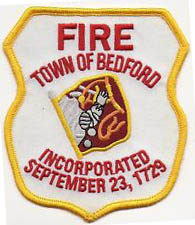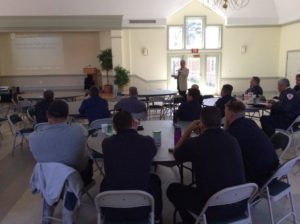
David Grunes, Fire Chief
55 The Great Road
Bedford, MA 01730
For Immediate Release
Friday, May 9, 2014
Contact: John Guilfoil
Phone: 781-533-9398
Email: john@jgpr.net
Bedford Fire Department Hosts Advanced Structure Fire Training Program with 7 Fire Departments
Changing the Way We Build Houses has Changed the Way Firefighters Fight Fires
Chiefs, Fire Officers, and Firefighters from Bedford, Concord, Lexington, Burlington, Billerica, Lincoln, and Nashua N.H. Participated
Bedford Fire Chief David Grunes announces that the more than 70 firefighters from seven area communities recently took part in a two-day advanced training program.
The class, “Tactical and Strategic Perspectives of Residential House Fires” showed firefighters how changing the way we construct houses and buildings have created an entirely new set of challenges for firefighters. A lack of knowledge or awareness of these challenges is dangerous and potentially deadly for firefighters.
“Suburban fire departments face a number of changes during structure fires, and those challenges have grown as building materials change,” Chief Grunes said. “I am pleased that Bedford was able to offer this course, and I would like to thank our instructors and partners who made it happen.”
The course was taught by P.J. Norwood, Training Officer/Deputy Chief of the East Haven, Conn. fire department and Jim Duffy, Shift Commander and Public Information Officer of the Wallingford, Conn. Fire Department.
This highly interactive eight-hour class offered local suburban firefighters a rare global perspective on incident command, search and rescue, fire attack/ventilation, and firefighter safety at house fires. The class involved advanced fire simulation software, real-life incident videos, and photographs to reinforce the points and involve the firefighters in the class.
Today’s houses are built with a plethora of synthetic and plastic materials. Windows are increasingly built to resist wind and storm damage — and, thus, firefighter’s tools. Roofs that look like wood or traditional shingles are now often made of plastic, concrete, or even metal, simulated to look like “traditional” roofs. Some solar panels are now built directly into roof shingles, making them virtually impossible to detect to an unknowing firefighter.
“Today’s firefighters are facing an extremely hostile fire environment that we have not seen in the past,” Deputy Norwood said. “Through science, data collection and Federal expertise, we can test our tactics in safe environments and then communicate best practices to firefighters for the real thing.”
These materials burn differently, are more difficult to clear or cut through, and often emit toxic fumes, posing extreme dangers to firefighters and residents.
“As building methods change, firefighting methods have to change as well,” said Bedford Fire Captain Mark Sullivan. “Every fire department needs to take a class like this. It may save buildings from total loss, and it could save firefighter and civilian lives.”

“This class will profoundly affect our operational perspective at incidents,” said Concord Fire Chief Mark Cotreau. “There are so few opportunities to get all of the fire officers from just Concord, let alone six other departments, in the same room, so it was great to get all of this information first hand. Additionally, training with our mutual aid communities, who are critical components to our emergency response, was extremely valuable.”
Each of the communities involved in the training session provide mutual aid to each other for fires and major incidents. It was important for each chief to make sure their staff received the same information, because the departments help each other in their towns when emergencies strike.
It was also important to bring in trainers from similarly-sized, suburban communities who face the same staffing and manpower challenges that Massachusetts suburbs face. A lot of fire training sessions assume that departments have four, even five firefighters on each truck. In most suburban departments, however, there are only two firefighters on each truck. The class was very helpful to the firefighters, because it was taught from their own perspective.
“The class featured two dynamic speakers who brought excellent, different training perspectives to departments like ours,” said Lexington Assistant Fire Chief Ken Tremblay. “Our department further benefited by training with nearby departments and creating important relationships off the fireground. Overall, it was well received, well presented and a job well done by the Bedford Fire Department for organizing.”
“Anytime we’re dealing with topics that might save firefighter or civilian lives, it’s a must-attend,” said Burlington Assistant Chief Mike Patterson. “This was a very informative class, and I am glad we were all in the same room for it.”
The class was funded by a Federal Emergency Management Agency Assistance to Firefighters Grant. It was taught on Wednesday, May 7 and Thursday, May 8 at St. Michael’s Parish Hall in Bedford. Classes such as these cannot be presented without support from the community and the following organizations provided direct support of the program; St. Michael’s parish, The Bedford Glen Doubletree hotel and the Bedford Firefighters Association Local 2310
Chiefs, Fire Officers, and Firefighters from Bedford, Concord (Mass.), Lexington, Burlington, Billerica, Lincoln, and Nashua (N.H.) participated in the class.
About the FEMA Assistance to Firefighters Grant Program
 The primary goal of the Assistance to Firefighters Grants (AFG) is to meet the firefighting and emergency response needs of fire departments and nonaffiliated emergency medical service organizations. Since 2001, AFG has helped firefighters and other first responders to obtain critically needed equipment, protective gear, emergency vehicles, training and other resources needed to protect the public and emergency personnel from fire and related hazards.
The primary goal of the Assistance to Firefighters Grants (AFG) is to meet the firefighting and emergency response needs of fire departments and nonaffiliated emergency medical service organizations. Since 2001, AFG has helped firefighters and other first responders to obtain critically needed equipment, protective gear, emergency vehicles, training and other resources needed to protect the public and emergency personnel from fire and related hazards.
Discover more from John Guilfoil Public Relations
Subscribe to get the latest posts sent to your email.